Skin Tonics, Astringents and Toners
Early beauty culturists stressed the importance of toning, stimulating or freshening the skin after cleansing with some form of skin tonic, skin freshener or astringent. These products were very popular and remained so throughout the twentieth century.
Skin Tonics
Originally, skin tonics were perceived as just that, tonics for the skin. Like their historical relatives, toilet waters, they were extremely variable in composition and often came with medicinal claims. Women in the nineteenth and early twentieth centuries could make skin tonics at home using recipes published in beauty books, household encyclopaedias and newspapers using ingredients purchased through local druggists or chemists.
Bernhardt’s Skin Tonic.
Sarah Bernhardt, who is well known for her perennial youthfulness, attributes the seeming miracle entirely to a special skin tonic which she favours. This eau sedative is said to have the effect of making the flesh firm and elastic, whilst strengthening and whitening the skin, and soothing the terrible “nerves” to which our twentieth century womanhood seems a ready prey. The recipe for the lotion is as follows:
– Half a pint of alcohol, two ounces of spirits of camphor, two ounces of spirits of ammonia, and five ounces of sea-salt, to be added to sufficient boiling water to make a quart in all, when the mixture should be placed in a bottle and thoroughly shaken before use. This lotion, which should be well rubbed into the skin daily, is said to be especially efficacious in taking the fatigue out of tired muscles.(Examiner, Launceston, Tasmania, 1904)
The idea that skin tonics could ‘soothe the nerves’ or ‘take the fatigue out of tired muscles’ is not unusual for the time. Similar medicinal claims were made for toilet waters and toilet vinegars in past centuries. For example, before it became a toilet water, Eau de Cologne (Cologne water) was used as a medicinal product both internally and externally to cure everything from epilepsy to worms. By comparison, claims for skin tonics were therefore subdued.
Formulation
Common ingredients used in skin tonics included alcohol, witch hazel extract, tincture of benzoin, tincture of sage, camphor and borax. Pink appears to have been the favoured colouring.
Skin tonic per cent Tincture of benzoin 1.25 Boric acid 0.5 Glycerin 18.3 Perfume 0.2 Alcohol 40 Witch hazel 9.75 Orange flower water 40 Procedure: Dissolve the tincture of benzoin and perfume in the alcohol. Warm the witch hazel and dissolve the boric acid in it. Mix the with hazel and the orange flower water; add glycerin. Then add the tincture and alcohol. Mix thoroughly, age, and filter.
(Chilson, 1934, p. 214)
However, many formulations were simple mixtures of perfumed water, alcohol and borax. For example, Elizabeth Arden’s Ardena Skin Tonic consisted mostly of water with small amounts of ethyl (grain) alcohol, boric acid and some perfume, and Dorothy Gray’s Orange Flower Skin Lotion was made mostly of water with a little alcohol, borax and some perfume (Philips, 1934).
How astringents work
Early Beauty Culturists knew from experience that astringents had a cooling and/or tightening effect on the skin but the mechanism was not well understood. One suggestion is that they affect keratin, the main skin protein. Salt bonds in keratin are affected by pH and temperature and will only form if the skin is slightly acidic or cool. If the salt bonds are broken, the keratin molecules move further apart from each other and the stratum corneum swells. If the skin is cooled, the salt bonds reform producing a tightening effect on the skin.
A cooling affect on the skin can be achieve by adding materials such as alcohol that evaporates quickly; splashing cold water on the face; using an ice pack; or by applying an aromatic compound such as menthol, sage or camphor that stimulates the cold sensing nerves in the skin to constrict the surface blood vessels.
It was once believed that skin tonics not only cooled/refreshed the skin and stimulated blood circulation, but that they also closed pores. It was thought that pores could become clogged if they remained open, causing pimples and blackheads, so skin tonics were seen as an important skin-care cosmetic. These early ideas about the nature of skin pores were misguided. Many beauty experts not only conflated the openings of sweat glands with those of the sebaceous glands but also wrongly thought they were opened and closed by muscles.
What are commonly called “pores” are tiny sweat or oil glands. Normally their openings upon the skin are very minute, but when they become choked with their own secretions, mixed with dust from the air, and when the muscle fibres that are intended to keep their outlets closed become relaxed, then these little glands are called blackheads or enlarged pores.
(Leeds & Kaji, 1927, p. 42)
Accordingly, if you believed that ‘pore muscles’ became relaxed during cleansing, it makes sense that they needed to be contracted before a vanishing cream or face powder was applied to prevent the cream or powder from clogging the pores. Consequently, a skin tonic with astringent properties was seen as an important cosmetic in the fight against blemished skin.
Few women realize how much the right skin tonic contributes to the beauty of their skin. Those who do, always use Vivatone, the Perfect Skin Tonic. Vivatone is ideal for closing the pores after a thorough cleansing with Daggett & Ramsdell’s Perfect Cold Cream. It stimulates the circulation and gives you that fresh, youthful appearance everyone admires.
(Daggett & Ramsdell advertisement, 1936)
Manual therapies – such a massage, patting, slapping and friction, with or without a steamer – that often accompanied the use of astringents can produce temporary inflammation (swelling) of the skin tissue making pores less visible. This helped give credence to the idea that astringents helped close pores up. However, we now know that there are no ‘pore muscles’ and the tightening effect of astringents is largely sensory and not permanent.
See also: Enlarged Pores
Cold water and ice
The generally accepted alternative to astringents for ‘closing the pores’ was to splash the face with cold/iced water or to rub it with ice.
To cleanse the pores first apply cold cream and wipe it off. Then make a thick lather with tincture of green soap or Castile soap and hot water upon a face cloth. Hold the cloth over the affect skin area. Before it cools renew the application of hot lather. Repeat several times, but stop as soon as the skin begins to feel sensitive. Rinse thoroughly in clean, warm water, then in cool. This treatment will dissolve the oily grime in the pores and wash it away.
Next comes the astringent application which causes the muscle fibres that have relaxed with the heat to tighten up and close the tiny openings in the skin. Wrap a piece of ice the size of an egg in a clean handkerchief. Rub the skin with the ice in an upward, rotary direction for several minutes. When the skin is especially sensitive and tender the ice rub may be omitted and cold-water compress substituted. Dry well.(Leeds & Kaji, 1927, pp. 43-44)
Needless to say, few beauty companies recommended this practice whole-heartedly even though ice was often used in salon treatments. Astringents and skin tonics were an important part of their strategy to get women to move away from soap and water to a more profitable cleanser and toning regime. Hard water, irritating alkaline soaps and spider veins caused by ice rubs, were all arguments used by cosmetic companies to get women to switch.
Marie Earle is the specialist who says DO NOT WASH YOUR FACE
If we could all arrange to live in Killarney or by the Italian lakes, where the weather is gentle and mild, it might be safe to make a practice of washing our faces. But in this climate, with its twelve months of devastating changes no skin can ever have “normal conditions.” Face-washing in America is not only undesirable, but positively dangerous.
Sensitive skin is irritated, dried, wrinkled, by the combination of water that is hard and soap that is alkaline. The complexion needs careful cleansing with the most exquisite cream made—Marie Earle’s Essential Cream. It needs nourishing with that same cream, rich in vegetable oils. Cucumber Emulsion, used with the Essential Cream, makes the latter absorb more readily and twice as effective. … Then for freshening the skin and leaving it soothed, the right Marie Earle lotion.(Marie Earle advertisement, 1928)
Astringents
Calling a product an astringent usually meant that it had a stronger formulation, i.e., contained more alcohol and/or included aluminium or zinc salts. For example, Helena Rubinstein’s Astringent Wash contained water with small amounts of menthol, zinc sulphate and perfume. However, the practice was by no means universal, so Primrose House’s Mild Astringent, which contained water, alcohol and a little glycerine and borax could also have been called a skin tonic.
Some beauty firms used this differentiation to make products for different skin types, making a ‘skin tonic’ for normal skins and an ‘astringent’ for oily skins.
Effective protection from exposure is assured by Dorothy Gray’s Orange Flower Skin Tonic, a mild refreshing astringent which should always be used to close the pores and refine the skin’s texture.
Astringent Cream is an exquisitely light and fluffy finishing preparation, ideal for dry or normal skins, which helps to protect the skin and holds make-up smoothly for many hours.
Astringent Lotion is the perfect finishing preparation for oily skins. It checks troublesome shininess and leaves a light film of fragrant powder on face and throat.(Dorothy Gray advertisement, 1928)
Another way of differentiating these products was to suggest that they be used in at different times of the day. Astringent creams were often recommended to be used at night, while astringent lotions were suggested to form part of a skin-cleansing routine before make-up was applied during the day. Again, there were plenty of exceptions to this rule.
As well as being used to remove excess oil and close skin pores, astringents were also used to treat loose or flabby skin (believed to be one of the main causes of wrinkles), puffiness under the eyes, to tighten crepiness in the throat and reduce double chins.
If you have allowed your contour muscles to grow lazy, if you have permitted a sluggish circulation to rob your facial tissues of vitality, then deep, discouraged lines will inevitably mar the loveliness of your face, and a sagging chin line will bear witness to your neglect. Sanely and systematically, you must tighten the muscles of your face and throat, make your tissues firm, and restore the velvety texture to your skin.
Dorothy Gray, after years of study, perfected a facial treatment known as the Alimenteau Astringent Treatment. It lifts and tightens the facial muscles and gives new vitality to the tissues by stimulating a healthy circulation and lubricating the skin.(Dorothy Gray advertisement, 1924)
Cures for wrinkles varied between beauty experts but many reasoned that if skin tonics could cause pore muscles to contract, then a stronger astringent could tighten relaxed facial muscles and reduce the flabbiness and wrinkles this caused. This idea, which had been around in the nineteenth century, persisted right through the 1920s and 1930s.
Every woman dreads CREPEY THROAT
What a fateful day when those faint lines appear in the neck and throat! Youthful contours slip away, dreaded wrinkles appear and the once firm neck muscles grow soft.
… Herbal Throat and Neck Blend is really amazing in its results! You first cleanse the skin with MISS DENNEY’S Herbal Cleansing Cream, then pat the throat and neck with her Special Astringent, so necessary to tighten relaxed muscles. Next dry the skin and apply the Throat and Neck Blend, patting it for a few minutes. Leave on overnight. You will marvel at the way lines and wrinkles will vanish if you follow this Treatment.(Frances Denney advertisement, 1934)
Wrinkle and loose skin treatments that used astringents often included manual therapies, skin foods, muscle oils and/or circulation creams in the treatment plan as these were also believed to improve circulation, firm skin or help build-up underlying tissue. The treatment below is prescribed by Marinello in 1915. It uses a medicated soap and an astringent combined with patting and iontophoresis.
The Astringent Treatment
This treatment must be varied to suit the individual case, though in general these directions may be followed. If the skin is very oily, the medicated soap may be made into a paste and applied to the face and neck, allowing it to remain for about ten minutes. Then it may be removed and the Astringent Cream applied before giving finger manipulations. The skin beneath the chin may be given more strenuous treatment by pinching the portion gently between the finger tips, while that between the eyes should be gently stroked.
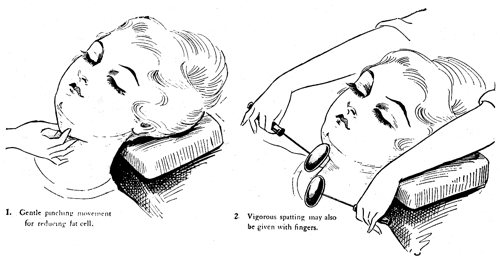
Following this treatment, every bit of the oil may be removed by means of the lavender lotion and the Astringent Cream forced into the skin by wrapping cotton soaked with this lotion around the carbon electrode, then attaching the electrode to the Positive Galvanic Current. This should be continued at least 12 minutes; longer in extreme cases.
After a few moments, strips of cotton may be saturated with the lotion and applied … with the exception that the cheeks and forehead should also be covered.
The mallets may be used for gentle tapping motion over the cotton.
If the skin sags very much, a gauze bandage saturated with the lotion may be used over the forehead and beneath the chin and the cotton placed as usual. This bandage may be used during the treatment in the office and at home too.
Following the tapping process, usually it will only be necessary to apply the powder and thus finish the treatment.
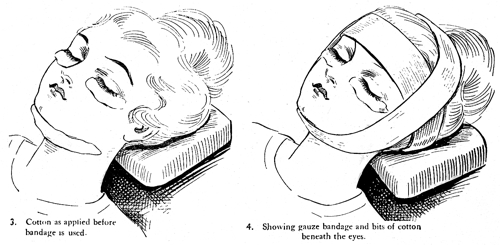
When the skin is very dry, the Lettuce Cream may be used for cleansing and then the massage given after the Tissue Cream has been forced in with red light. The Astringent Cream may be used for the massage and the treatment given as before, with the exception that often after the use of the lotion, the skin may look a little dry or rough and it may be advisable to apply either a little more Astringent Cream or perhaps some of the Lily Jelly before using any powder.
This treatment leaves the skin feeling firm, fresh and cool to the touch. It produces a quick and a very pleasing result and where the condition is extremely oily, if home work is done persistently, the results are even better than when the skins are flabby and dry.
In either case, the use of the Positive Galvanic Current is of great use in the treatment.(Lloyd, 1915, pp. 92-93)
See also: Skin Foods, Iontophoresis, Patters, Massage, Wrinkles and Double Chins, Red Light, Blue Light and Circulation Creams.
Of course, not everyone made such claims. For many, astringent creams or lotions were simply applied to correct excessive oiliness. They were also used in other branches of cosmetics, namely aftershaves, mouthwashes and antiperspirants.
Toners
In the 1940s, the American Food and Drug Administration (FDA) disallowed many of the claims made for astringents and skin tonics in the United States, particularly claims that astringents could improve skin elasticity or close pores. Outside the United States, the idea that they ‘tightened pores’ and ‘stimulated surface circulation’ persisted, particularly in those countries without good consumer safeguards. For example, in 1960, Dorothy Gray was still advertising its toner in Australia as being essential because it “prevents open pores, stimulates circulation and removes all traces of cleansing cream” (Dorothy Gray advertisement, 1967) something it would not have been able to do in America.
Given the profitability associated with skin tonics and astringents, most cosmetic companies persisted with them, claiming that they restored the skin pH, removed remaining cleanser, left the skin feeling fresh and/or wiped off excess oil. However, after the Second World War the term astringent became associated with harshness, so many products were rebadged as toners.
By the 1960s, the introduction of the moisturiser meant that most cosmetic companies had settled on some form of a ‘cleanse, tone and moisturise’ routine with toners being used to ‘clarify’ and ‘refine’ the skin – terms that were vague enough to avoid trouble with regulators. The rise of post-war youth culture also saw a greater use of medicated astringents and toners. As these were generally classified as pharmaceutical products, rather than cosmetics, they generally had to pass a higher level of regulatory testing, but the testing also meant the products could make more explicit claims to improving the skin.
Astringents and toners today
Although not as prominent as they were in the past, astringents and toners are still used today. Compared to most of the early products, modern astringents and toners are complex formulations. They are often alcohol free and include humectants such as propylene glycol or sorbitol to help reduce dehydration, pH adjusters like citric acid to help in the tightening effect on keratin, soothing agents to calm the skin, and/or antiseptic or antimicrobial agents to help blemished skins.
First Posted: 20th September 2010
Last Update: 22nd May 2022
Sources
Chilson, F. (1934). Modern cosmetics. New York: Drug & Cosmetic Industry.
DeNavarre, M. G. (1941). The chemistry and manufacture of cosmetics. Boston: D Van Nostrand Company.
Harry, R. G. (1940). Modern cosmeticology: The principles and practices of modern cosmetics. Brooklyn, NY: Chemical Publishing Company.
Leeds L., & Kaji, I. (1927). Beauty and health: A practical handbook. Philadelphia: J. B. Lippincott.
Lloyd, E. (1915). The Marinello text book (2nd. ed.). Chicago: The Marinello company.
Phillips, M. C. (1934). Skin deep: The truth about beauty aids. New York: Garden City Publishing.
Sagarin, E. (Ed.). (1957). Cosmetics: Science and technology. New York: Interscience Publishers, Inc.
Verni, M. (1946). Modern beauty culture (2nd ed.). London: New Era Publishing.
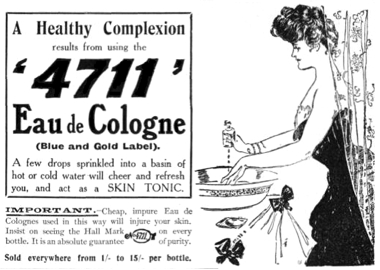
1907 ‘4711’ Eau de Cologne used as a skin tonic.
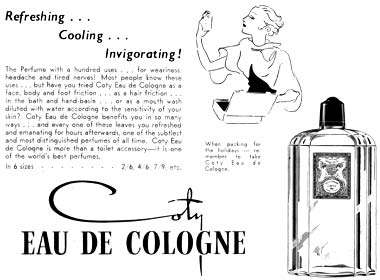
1936 Coty Eau de Cologne. “The Perfume with a hundred uses … for weariness, headache and tired nerves! Most people know these uses … but have you tried Coty Eau de Cologne as a face, body and foot friction … as a hair friction … in the bath and hand basin … or as a mouth wash diluted with water according to the sensitivity of your skin?”
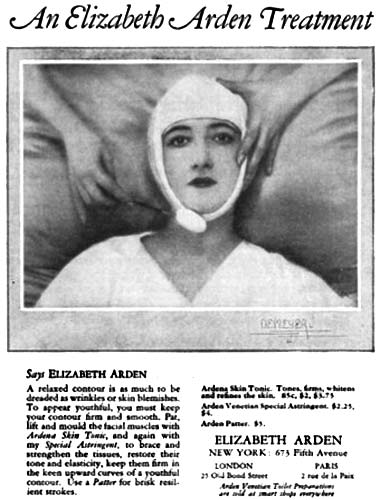
1925 Elizabeth Arden “Pat, lift and mould the facial muscles with Ardena Skin Tonic, and again with my Special Astringent, to brace and strengthen the tissues, restore tone and elasticity, keep them firm in the keen upward curves of a youthful contour.”

1930 Listerine. The use of a mouthwash as an astringent.
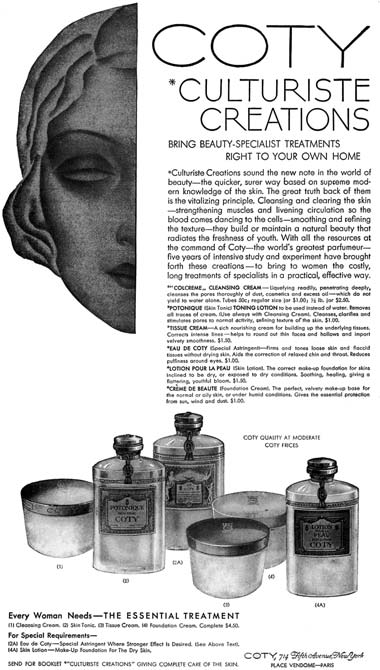
1930 Coty Culturiste Creations including Potonique (Skin Tonic) Toning Lotion and Eau de Coty (Special Astringent). “Culturiste Creations sound the new note in the world of beauty—the quicker, surer way based on supreme modern knowledge of the skin. The great truth back of them is the vitalizing principle. Cleansing and clearing the skin—strengthening muscles and livening circulation so the blood comes dancing to the cells—smoothing and refining the texture—they build or maintain a natural beauty that radiates the freshness of youth.”
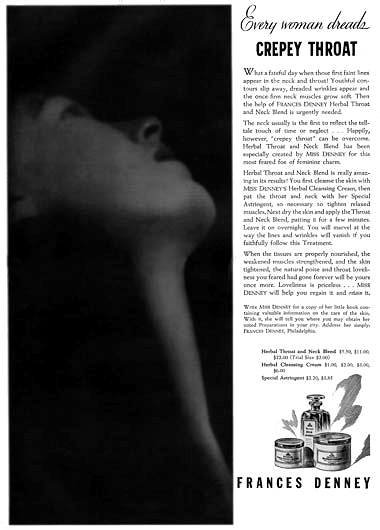
1934 Frances Denney ‘Every woman dreads CREPEY THROAT.’
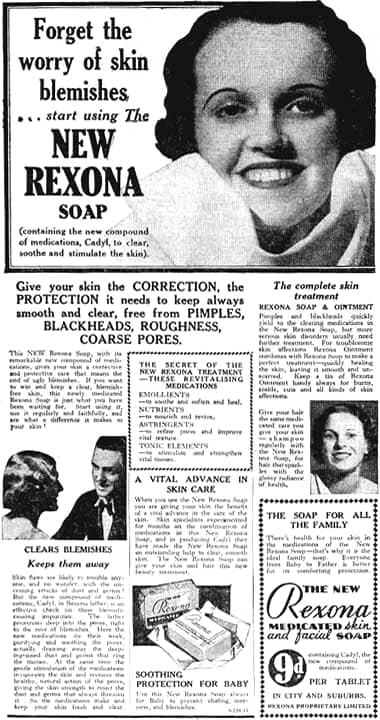
1934 Rexona Medicated Soap. Soap manufacturers were not above making similar claims to the cosmetic companies. This soap apparently contained emollients (to soothe, soften and heal), nutrients (to nourish and revive), astringents (to refine pores and improve vital texture) and tonic elements (to stimulate and strengthen vital tissues).
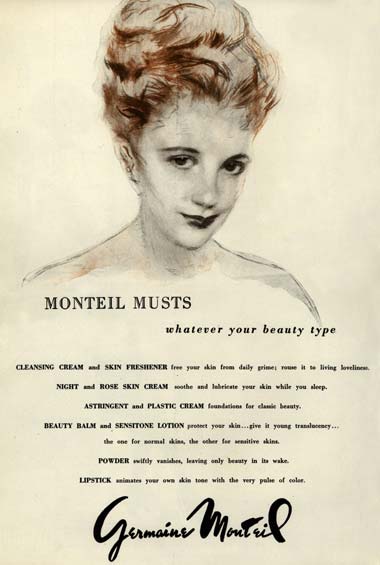
1946 Germaine Monteil Skin Freshener and Astringent.
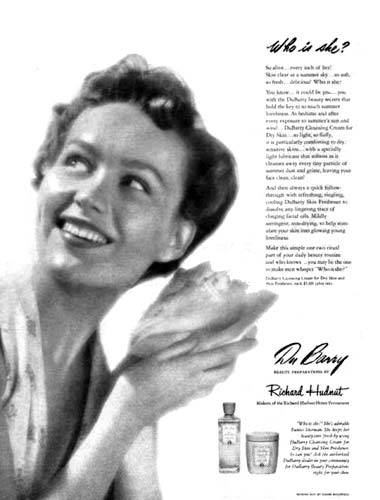
1949 Richard Hudnut Du Barry Cleansing Cream and Skin Freshener. “And then always a quick follow through with refreshing, tingling, cooling Du Barry Skin Freshener to dissolve any lingering trace of clinging facial oils. Mildly astringent, non-drying, to help stimulate your skin into glowing young loveliness”.
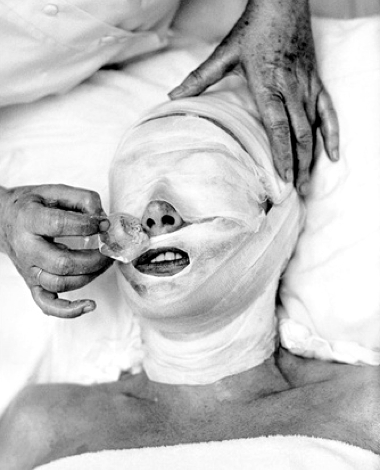
1959 Ice being used as part of a facial treatment.

1959 Shulton Ice-O-Derm Medicated Astringent. The rise of youth culture after the Second World War saw the arrival of a number of medicated astringents. Technically these were pharmaceuticals rather than cosmetics.
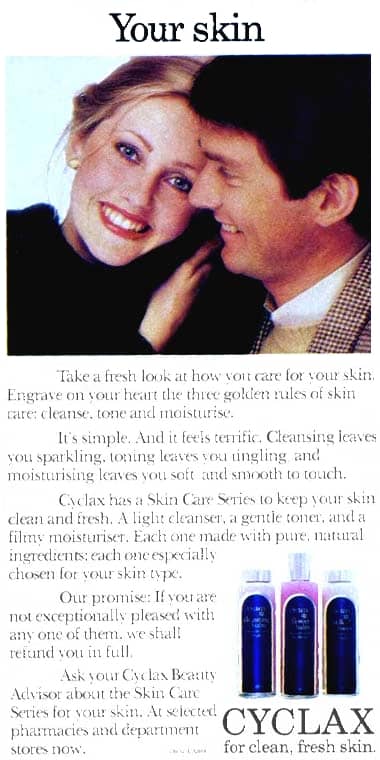
1980 Cyclax products using the now ubiquitous routine of cleanse, tone and moisturise.
